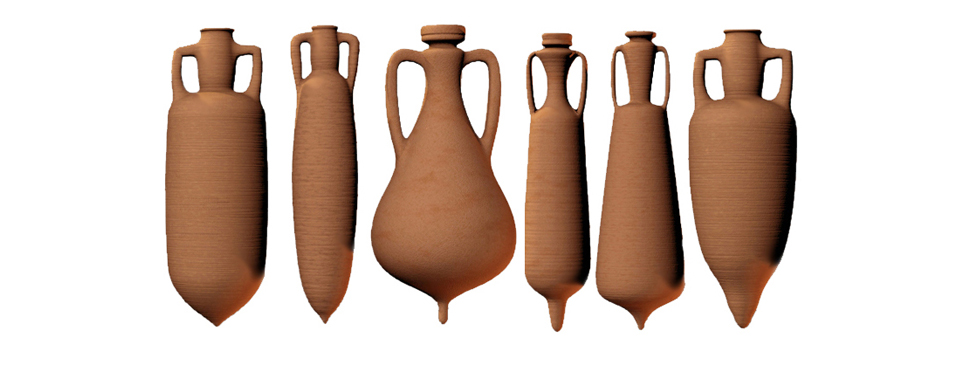The Port of Roman London

Imports to Londinium from southern Europe included oil, wine and fish sauce, which would have been kept in amphorae such as these. They came in various shapes and sizes and typically held about 24-30 litres. Their shape is to make them convenient for carrying. Larger ships could carry thousands on a single voyage. Many fragments of them have been found at certain sites during excavations along the former Roman-era waterside of Londinium, and have been traced back to France, Spain, Italy, North Africa and the eastern Mediterranean. They could be in use for long periods, often lasting a hundred years.
Ships were unloaded by dockers known as sacarii, who carried loads across planks from ship to shore. As most goods arrived or departed during the summer months the men were probably employed as required, perhaps as casual labourers.
Importation and exportation was a dangerous business, with large investment in the vessels and their cargoes, a high financial risk but high reward. Much of the cost was raised in the form of syndicates of wealthy men who would not be ruined in the event of a ship being lost at sea, something similar to modern-day insurance, and one that was known as ‘bottomry’. At first the ships arriving at Londinium were owned by traders from other parts of the empire but there is evidence of later shipbuilding, which indicates ownership by locally-based traders.
Romans did not generally operate fishing boats on the rough North Sea. Fish to feed Londoners was mostly caught in the Thames Estuary in small boats and then brought upriver. Fish consumed in London included cod, herring, sprat, bass, bream, flatfish, carp, and smelt, as well as eel. Oysters were cultivated along the Kent and Essex coasts and brought to Londinium for consumption or for export around the empire. Fish sauce, known as garum, was popular throughout the empire. In the early decades it was imported from Spain but thereafter seems to have been produced locally.
From the 3rd century the Roman Empire went into decline. In 276 Gaul was temporarily over-run by barbarians from the north and from the 360s the coasts of Gaul and Britannia were being attacked by Saxons and Franks. The city wall had previously extended around the landward sides of Londinium but was then hastily extended along the riverside. This would have separated the quayside from the rest of the town and presented a major obstacle to the loading and unloading of vessels. A possible look-out tower was also erected at Shadwell.
The port of Londinium had evolved and grown during the 1st to 3rd centuries but there were no major advances following the building of the riverside wall. The quayside was allowed to fall into decay, and the river silted up. It appears that shipping declined on the Thames during the 4th century.
Over many millennia sea levels have risen and fallen, which affected the Thames. The level of the river seems to have begun falling so that by the 5th century the tidal head no longer reached as high as Londinium, making it difficult for ships to reach the town.
It was during the 5th century that Londinium was abandoned and left to ruin for the next few centuries. Certainly, 500 years later, in the late-Saxon period when the town was reoccupied, the river level had risen again, allowing ships to once again reach London.
Sources include: Gustav Milne ‘The Port of Roman London’; John Morris ‘Londinium – London in the Roman Empire’; Gustav Milne ‘The Growth of London as a Port from Roman to Medieval Times’, Gresham College lecture, October 2016; Simon Webb ‘Life in Roman London’; Dominic Perring ‘Roman London’; Di Murrell ‘Barges & Bread’; Peter Marsden ‘Ships of the Port of London, First to eleventh centuries AD’.
< Back to Roman London
< Back to The Port of London


